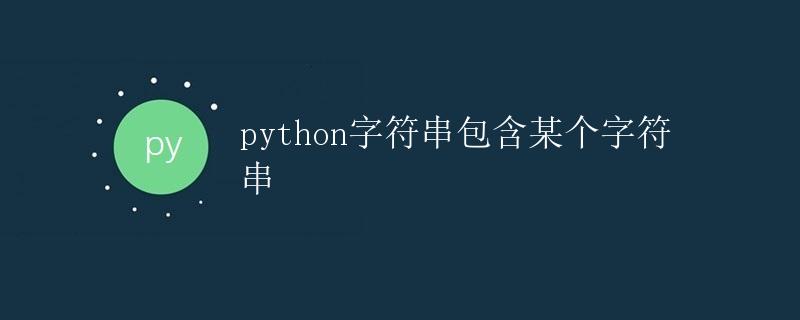Python字符串包含某个字符串

1. 介绍
在Python中,可以使用多种方式判断一个字符串是否包含另一个字符串。字符串是Python中常用的数据类型之一,它由字符组成,可以进行很多操作。判断一个字符串是否包含另一个字符串,在实际开发中经常会遇到,本文将详细介绍不同方法来判断字符串包含。
2. 使用in运算符
Python中的in运算符可以判断一个字符串是否包含另一个字符串。具体使用方式如下:
string1 = "Hello World"
string2 = "Hello"
if string2 in string1:
print("string1包含string2")
else:
print("string1不包含string2")
运行以上代码,输出为:
string1包含string2
上述代码中,使用in运算符判断string2是否在string1中,如果在则输出”string1包含string2″,否则输出”string1不包含string2″。
3. 使用find方法
字符串对象提供了find方法用于查找一个子字符串在整个字符串中的位置。如果找到了子字符串,则返回它在字符串中的起始位置,如果找不到则返回-1。具体使用方式如下:
string1 = "Hello World"
string2 = "Hello"
position = string1.find(string2)
if position != -1:
print("string1包含string2,位置在", position)
else:
print("string1不包含string2")
运行以上代码,输出为:
string1包含string2,位置在 0
上述代码中,使用find方法查找string2在string1中的位置,如果找到了则输出字符串的起始位置,否则输出”string1不包含string2″。
4. 使用index方法
与find方法类似,字符串对象还提供了index方法用于查找一个子字符串在整个字符串中的位置。如果找到了子字符串,则返回它在字符串中的起始位置,如果找不到则抛出ValueError异常。具体使用方式如下:
string1 = "Hello World"
string2 = "Hello"
try:
position = string1.index(string2)
print("string1包含string2,位置在", position)
except ValueError:
print("string1不包含string2")
运行以上代码,输出为:
string1包含string2,位置在 0
上述代码中,使用index方法查找string2在string1中的位置,如果找到了则输出字符串的起始位置,如果找不到则捕获ValueError异常并输出”string1不包含string2″。
5. 使用startswith和endswith方法
字符串对象还提供了startswith和endswith方法,用于判断字符串是否以某个子字符串开头或结尾。具体使用方式如下:
string1 = "Hello World"
string2 = "Hello"
if string1.startswith(string2):
print("string1以string2开头")
else:
print("string1不以string2开头")
if string1.endswith(string2):
print("string1以string2结尾")
else:
print("string1不以string2结尾")
运行以上代码,输出为:
string1以string2开头
string1不以string2结尾
上述代码中,使用startswith方法判断string1是否以string2开头,使用endswith方法判断string1是否以string2结尾。
6. 使用正则表达式
正则表达式是一种灵活、强大的字符串匹配工具,也可以用于判断一个字符串是否包含另一个字符串。Python的re模块提供了对正则表达式的支持。具体使用方式如下:
import re
string1 = "Hello World"
string2 = "Hello"
pattern = re.compile(string2)
result = pattern.search(string1)
if result:
print("string1包含string2")
else:
print("string1不包含string2")
运行以上代码,输出为:
string1包含string2
上述代码中,使用re.compile函数将string2编译为一个正则表达式模式,然后使用search方法在string1中搜索该模式,如果找到了则输出”string1包含string2″,否则输出”string1不包含string2″。
7. 使用count方法
字符串对象提供了count方法用于统计一个子字符串在整个字符串中出现的次数。具体使用方式如下:
string1 = "Hello World"
string2 = "l"
count = string1.count(string2)
print("string2在string1中出现的次数为", count)
运行以上代码,输出为:
string2在string1中出现的次数为 3
上述代码中,使用count方法统计string2在string1中出现的次数,并输出。
8. 总结
本文介绍了多种方法来判断一个字符串是否包含另一个字符串。根据实际需求可以选择使用in运算符、find方法、index方法、startswith和endswith方法、正则表达式或count方法来判断字符串包含关系。在实际开发中,根据具体情况选择最适合的方法能够提高代码的可读性和效率。
 极客教程
极客教程